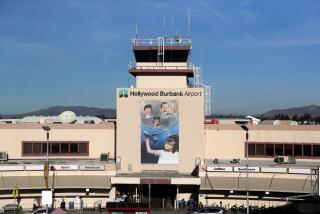Airport Balancing Act
- Share via
For eight years, the Clinton administration watched without taking significant action as the nation’s air passenger and air cargo system began to clog up like the San Diego Freeway on a Friday afternoon. At the very least, the Transportation Department and the Federal Aviation Administration should have used their bully pulpits to drive home the message that new and larger airports are essential for the safe and efficient movement of people and goods.
Instead, Clinton officials tried and failed to upgrade the nation’s air traffic control system, just as others had failed before. The Transportation Department pushed for greater security at airports but not for quicker ways to move people to and from terminals. It touted multi-modal transportation projects and sought to maintain America’s ability to move cargo, but it failed to speak out on behalf of airport expansion projects faced with strident local opposition.
The FAA wanted the airline industry to treat passengers better but did nothing to address the fact that only six runways were built at major airports in the United States in the 1990s, a period in which the number of airline passengers soared to more than 600 million a year. Small wonder that last year was the worst on record in terms of flight delays.
Now, the Bush administration has clearly staked out a new approach. It plans to speed construction of additional runways at major airports across the nation--which is the only thing that can help ensure timely arrivals and departures and help prevent runway disasters. To illustrate the problem, even as Los Angeles International Airport officials were receiving an award last month for improved runway safety, two Boeing 737s had a frighteningly close encounter.
The Bush proposal could have an impact on the efforts to expand LAX and to build a commercial airport at the former El Toro Marine base in Orange County. President Bush--backed by a number of business leaders, the Air Transport Assn. and executives from 12 airports, including those of Phoenix, San Francisco and Denver--says he wants to expedite required environmental impact reviews for the projects. Insofar as the reviews have been used around the country as an unreasonable tool of delay, that makes good sense. But there is also a concern that Bush will go too far and gut reasonable protections against noise pollution and environmental damage.
In a report last year, the General Accounting Office said it can take a decade or more to obtain approvals for an additional runway in the face of a ponderous process that does not always result in better noise and pollution protection. It’s also true that the nation must come to grips with a fundamental paradox: Americans are taking to air transportation in ever greater numbers but have never been more vehement in their opposition to expanding airport facilities. Some opposition groups have called for a moratorium on construction and expansion of airports.
It will take a delicate touch to streamline the airport expansion process while at the same time protecting the public. The jury’s still out on whether the Bush administration has such a deft hand.
More to Read
Inside the business of entertainment
The Wide Shot brings you news, analysis and insights on everything from streaming wars to production — and what it all means for the future.
You may occasionally receive promotional content from the Los Angeles Times.










